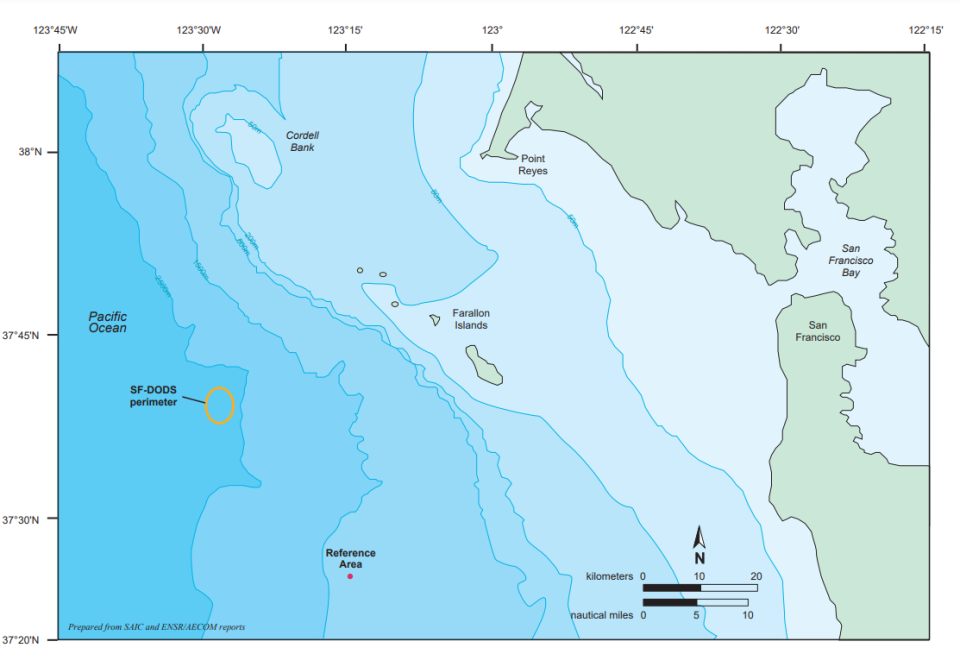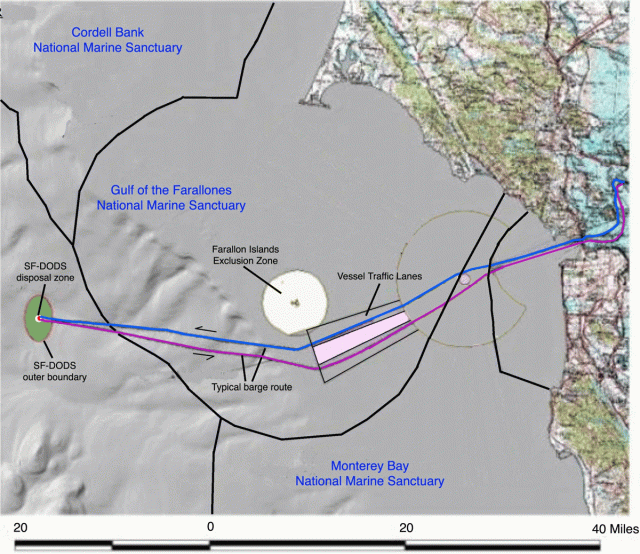A Sediment Testing Reference Area Database for the San Francisco Deep Ocean Disposal Site (SF-DODS)
- Background on Testing Sediment for SF-DODS Disposal
- The Reference Area Database
- Tables of Physical, Chemical and Biological Data
Background on Testing Sediment for SF-DODS Disposal
The San Francisco Deep Ocean Disposal Site (SF-DODS) is the deepest ocean dredged material disposal site in the United States. It is located off the Continental Shelf in approximately 8,200 to 9,800 feet (2,500 to 3,000 meters) of water, approximately 55 nautical miles (100 kilometers) offshore of San Francisco (Figure 1).
In order for U.S. Army Corps of Engineers (USACE) to authorize a permit for the disposal of dredged material at the SF-DODS, sediment evaluations (as described in the national testing manual, the Ocean Testing Manual) must first be conducted on the dredged material proposed for ocean disposal. EPA and USACE can determine suitability of dredged material for ocean disposal by comparing the test results of the proposed dredged material against the test results of a designated reference sediment. EPA identifies reference sediments as substantially free of contaminants and as representative as possible of what conditions at the disposal site would be if no dredged material had ever been disposed there.
The reference area identified by EPA for the SF-DODS is located in approximately 4,200 feet (1,285 meters) of water, at 37°25.00' N and 123°14.90' W (NAD 83). This site is approximately 20 nautical miles (35 kilometers) from the SF-DODS itself, and approximately 35 nautical miles (65 kilometers) from the California coast (Figure 2).

Just as the SF-DODS is the nation's deepest disposal site, its reference area is the deepest as well. The great water depth and open-ocean location of the reference site make the collection of its sediment very expensive and logistically difficult. Weather and sea-state conditions can force costly delays in project sampling programs and, in extreme conditions, can present a concern for human safety. For these reasons, EPA believes it is appropriate to establish and maintain a reference area database of previously-collected sediment test results that may be used in lieu of collecting and testing the reference area's sediment directly.
EPA anticipates that project proponents will typically elect to compare their test result against the appropriate values in the database when timing, cost or safety considerations present significant obstacles in collecting new reference site sediment. However, any project proponent may propose to compare their sediment test result against the most current sediment test results in the reference area database.
The Reference Area Database
Several sets of sediment test data have been successfully collected from the SF-DODS reference area since 1990. Physical, chemical and biological data from these studies are summarized in Tables 1 through 4.
- Table 1 depicts the range of bulk sediment chemistry values found at the reference site for all typical contaminants of concern.
- Table 2 shows solid phase acute toxicity bioassay results for two species of amphipods and two species of polychaetes.
- Tissue chemistry results are provided for all typical bioaccumulative contaminants of concern, for one clam species in Table 3, and two polychaete species in Table 4.
(Suspended particulate phase bioassays are not included in the database, since results from these tests are compared against water quality criteria as opposed to reference sediments.) Thus, all types of reference sediment data necessary for full Tier III OTM evaluations are included in the database.
Cautions for Project Proponents about Using the Reference Area Database
If you choose to compare your dredged material test data against the SF-DODS reference area database, you must use the same test species reflected in the database. You should use caution when comparing to the reference area database values, as this can result in disposal suitability determinations by EPA and the USACE that are slightly more conservative (more environmentally protective) than would be the case if the reference sediments were tested directly.
This is because, in this approach, you are directly (not statistically) comparing to the reference area database values. Therefore, when average amphipod mortality in a sediment sample is more than 20 percent above the overall average value in the reference area database, the test sediment is automatically considered unsuitable for ocean disposal. This will be true even if the test sediment and reference area sediment might not have been statistically different if they had been tested directly at the same time.
In the same manner, when polychaete mortality is more than 10 percent above the corresponding overall average value in the reference area database, it is considered unsuitable for ocean disposal.
Comparison of bioaccumulation test results to the reference area database also will be made directly, as opposed to statistically. For bioaccumulation data, EPA will evaluate test data generally against the range of tissue concentrations in the reference area database, as well as consider available published scientific information concerning tissue residue effects.
Before starting any sediment testing program that supports proposed ocean dumping at SF-DODS, you should work with the Region 9 EPA Dredging and Sediment Management Team to develop a draft Sampling and Analysis Plan. The Region 9 team must approve the Plan.
Tables of Physical, Chemical and Biological Data Collected from SF-DODS Reference Area
- Table 1a. Sediment Chemistry for the SF-DODS Reference Area: Conventionals
- Table 1b. Sediment Chemistry for the SF-DODS Reference Area: Trace Metals
- Table 1c. Sediment Chemistry for the SF-DODS Reference Area: Organics
- Table 1d. Sediment Chemistry for the SF-DODS Reference Area: Chlorinated Organic Pesticides
- Table 2. Percent Survival in Toxicity Bioassays of SF-DODS Reference Area Sediments
- Table 3a. Tissue Chemistry for the Clam Macoma nasuta Exposed to SF-DODS Reference Area Sediments: Trace Metals
- Table 3b. Tissue Chemistry for the Clam Macoma nasuta Exposed to SF-DODS Reference Area Sediments: Organics
- Table 3c. Tissue Chemistry for the Clam Macoma nasuta Exposed to SF-DODS Reference Area Sediments: Chlorinated Organic Pesticides
- Table 4a. Tissue Chemistry for Two Polychaete Species Exposed to SF-DODS Reference Area Sediments: Trace Metals
- Table 4b. Tissue Chemistry for Two Polychaete Species Exposed to SF-DODS Reference Area Sediments: Organics
- Table 4c. issue Chemistry for Two Polychaete Species Exposed to SF-DODS Reference Area Sediments: Chlorinated Organic Pesticides
NOTES
- Reported as total of 6 LPAHs: naphthalene, acenaphthylene, acenaphthene, fluorene, phenanthrene, anthracene
- Reported as total of 9 HPAHs:fluoranthene, pyrene, benzo(a)anthracene, chrysene, Benzo(b,k)fluoranthene, benzo(a)pyrene, dibenzo(a,h)anthracene, benzo(g,h,i)perylene, indeno(1,2,3-c,d)pyrene
- Reported as total of Aroclor equivalents 1242, 1248, 1254, and 1260
- Reported as total of Mono-, Di-, and Tri- and Tetrabutyltin
NOTE
- Direct (not statistical) comparison is made between these values and test sediment average survival results.
NOTES
- Reported as total of 6 LPAHs: naphthalene, acenaphthylene, acenaphthene, fluorene, phenanthrene, anthracene
- Reported as total of 9 HPAHs:fluoranthene, pyrene, benzo(a)anthracene, chrysene, Benzo(b,k)fluoranthene, benzo(a)pyrene, dibenzo(a,h)anthracene, benzo(g,h,i)perylene, indeno(1,2,3-c,d)pyrene
- Reported as total of Aroclor equivalents 1242, 1248, 1254, and 1260
- Reported as total of Mono-, Di-, and Tri- and Tetrabutyltin
NOTES
- Reported as total of 6 LPAHs: naphthalene, acenaphthylene, acenaphthene, fluorene, phenanthrene, anthracene
- Reported as total of 9 HPAHs:fluoranthene, pyrene, benzo(a)anthracene, chrysene, Benzo(b,k)fluoranthene, benzo(a)pyrene, dibenzo(a,h)anthracene, benzo(g,h,i)perylene, indeno(1,2,3-c,d)pyrene
- Reported as total of Aroclor equivalents 1242, 1248, 1254, and 1260
- Reported as total of Mono-, Di-, and Tri- and Tetrabutyltin

